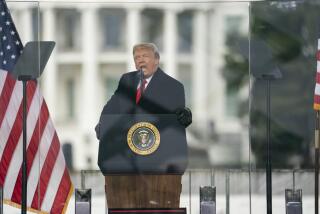BOOK MARK : The Scandal That Challenges the Legitimacy of Our Political Order
- Share via
As the principal White House aide for Iranian affairs during the Carter Administration, I was personal ly involved in the efforts to free the hostages, and I rode the emotional roller-coaster, along with all other Americans, from the time they were captured, through the eventful year of 1980, until they were finally released on Jan. 20, 1981. I was in the Oval Office on the morning of Ronald Reagan’s inaugural when the final agreements were cabled to Algeria, completing the terms of release. I was in the Situation Room as the hours dragged on, until Iran formally accepted the terms five minutes after Reagan was sworn in as President.
In the years that followed, I was approached from time to time by journalists asking for my comment on allegations that Republicans and Iranians had made a secret deal to delay the release of the hostages. My answer was always the same: The events of 1980 could be explained adequately without resort to what I considered to be a conspiracy theory based on little more than a coincidence of timing. To be sure, there were parts of the story that remained mysterious, but I thought I understood fairly well what had happened.
As time went on, seemingly inexplicable fragments of information began to appear. A single sentence in a brief article buried in the New York Times established the fact that William J. Casey, the Reagan campaign chairman, had been out of the country at the time several sources said he had been meeting with Iranians in Madrid. This contradicted the assertions of Casey’s associates that he had been in the United States on the dates in question. A single date in an affidavit suggested an effort by the Reagan Administration to cover its tracks immediately after the inauguration.
And in 1991, Reagan himself admitted to reporters that “I did some things . . . to try to be of help in getting those hostages.” When asked if that meant contacts with the Iranian government, he responded “Not by me.” When asked “by your campaign perhaps?” he responded, “I can’t get into the details. Some of those things are still classified.”
Certain iron rules apply whether one is studying the habits of birds or the behavior of nations. The first--and most inflexible--is that you never have enough evidence. So you begin by accumulating every possible scrap of information from any source and arranging this unwieldy mass of data into some kind of order, looking for patterns and clues to guide subsequent research.
This study was plagued by the absence of hard information. Any deal between a U.S. political party and a hostile foreign power was, by definition, a covert political action, and the participants could be expected to do everything in their power to conceal their footprints. The purpose of a covert action is to manipulate events and the perception of events in such a way that the desired outcome is achieved, while the participants remain unaware that they have been manipulated, or, if they suspect, to ensure that the truth can plausibly be denied. Casey, himself a spymaster in World War II, had directed secret operations behind German lines.
A second iron law, partly offsetting the first, is the coherence and internal logic of a sequence of events. It is possible to invent fanciful bridges to connect almost any sequence of political events. But those inventive connections, the speciality of the conspiracy theorist, cannot withstand close scrutiny. Facts do not exist in a vacuum; they grow out of events and, if they are part of a human scheme, they are rooted in some underlying logic.
When the Iran-Contra scandal exploded in 1986, both the Congress and the media pulled up short. Neither had the stomach for the kind of national trauma that would have resulted from articles of impeachment being delivered against a popular President who was in his last two years of office. So, when it could not be proved conclusively that the President saw the “smoking gun” in the case--a copy of a memo to Reagan reporting in matter-of-fact terms that proceeds of Iranian arms sales were being diverted to the Nicaraguan Contras--the nation seemed to utter a collective sigh of relief.
The ultimate dilemma, which Andre Chernier captured so perfectly in his comment on the revolutionary politics of 18th-Century France, is the effect of very high stakes. A run-of-the mill political scandal can safely be exposed without affecting anyone other than the culprits and their immediate circle. A covert political coup, however, like the one engineered by Casey in 1980, challenges the legitimacy of the political order; it deliberately exploits weaknesses in the political immune system and risks infecting the entire organism of state and society. Such a virus of secrecy and subterfuge would permeate the Reagan Administration and would culminate in the Iran-Contra Affair, the contours of which bore an uncanny resemblance to Casey’s 1980 deal to swap arms for hostages. One of the more puzzling aspects of the Iran-Contra affair was the Reagan Administration’s dogged pursuit of a deal in the face of repeated Iranian demands. Yet Reagan’s men refused to take no for an answer. The reason now seems plain: The same parties had cut a deal once before.
1991 by Gary Sick. Reprinted with permission from Random House.
BOOK REVIEW: “October Surprise: America’s Hostages in Iran and the Election of Ronald Reagan,” by Gary Sick, is reviewed on Page 1 of the Book Review section.
More to Read
Sign up for Essential California
The most important California stories and recommendations in your inbox every morning.
You may occasionally receive promotional content from the Los Angeles Times.













